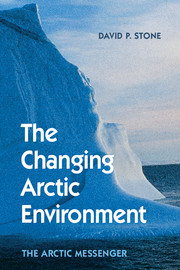Book contents
- Frontmatter
- Dedication
- Contents
- Acknowledgements
- Acronyms
- 1 Personal Beginnings
- PART I THE CHANGING ARCTIC
- PART II WORKING TOGETHER
- PART III WHAT IS THE PRESENT STATE OF KNOWLEDGE?
- PART IV WHAT DOES ALL THIS MEAN?
- 11 Thoughts on Education, the Training of Arctic Scientists, and Arctic Research
- 12 The Long and the Short of It: Has the Arctic Messenger Been Noticed? What Can Be Done?
- 13 Epilogue: Keeping the Rovaniemi Flame Alive
- Appendix I The Intergovernmental Panel on Climate Change (IPCC)
- Appendix II What Will Happen in the Future If We Do Nothing or If We Try Very Hard to Aggressively Reduce GHG Emissions: Projected Change Under Different Emission Scenarios
- Appendix III Some Geophysical Background Notes Related to Climate and Weather
- Appendix IV Orbital Forcing
- Appendix V The Concept of Commitment
- Bibliography
- Credits
- Index
11 - Thoughts on Education, the Training of Arctic Scientists, and Arctic Research
from PART IV - WHAT DOES ALL THIS MEAN?
Published online by Cambridge University Press: 05 February 2015
- Frontmatter
- Dedication
- Contents
- Acknowledgements
- Acronyms
- 1 Personal Beginnings
- PART I THE CHANGING ARCTIC
- PART II WORKING TOGETHER
- PART III WHAT IS THE PRESENT STATE OF KNOWLEDGE?
- PART IV WHAT DOES ALL THIS MEAN?
- 11 Thoughts on Education, the Training of Arctic Scientists, and Arctic Research
- 12 The Long and the Short of It: Has the Arctic Messenger Been Noticed? What Can Be Done?
- 13 Epilogue: Keeping the Rovaniemi Flame Alive
- Appendix I The Intergovernmental Panel on Climate Change (IPCC)
- Appendix II What Will Happen in the Future If We Do Nothing or If We Try Very Hard to Aggressively Reduce GHG Emissions: Projected Change Under Different Emission Scenarios
- Appendix III Some Geophysical Background Notes Related to Climate and Weather
- Appendix IV Orbital Forcing
- Appendix V The Concept of Commitment
- Bibliography
- Credits
- Index
Summary
“The great aim of education is not knowledge but action.”
Herbert Spencer, English philosopherBefore starting this chapter, I have to admit I have no educational expertise. To share my thoughts on education is presumptuous or foolhardy or hazardous. It is probably all three. However, I am going to take the risk. I firmly believe that the importance of environmental education cannot be overestimated. Three aspects really surprise me when talking to non specialists about the state of the Arctic environment and of its implications to the environments in which most of us live. The first is the general public's high level of interest in the Arctic. The second is how little many people know about the Arctic and environmental sciences in comparison with their understanding of topics that are more demanding on the mind. The third is the widespread reach of many misconceptions about the state of the Arctic and global environments.
As global society moves deeper into the twenty-first century, it is clear that socioeconomic models of the last two centuries are unsustainable. Our globe has limited resources and limited capacity to deal with our persistent wastes. Developing countries are determined to gain their fair share of global resources and attain lifestyles presently only enjoyed in developed countries. Our unrelenting use of hydrocarbons to power our economies is fundamentally altering Earth's climate system in a way that will be difficult to reverse. At the same time, the global human population is increasing. It grew from 1 billion to 7 billion between 1800 and 2011 and it will hit 8 billion by 2025. It will pass 10 billion in 2040. We are entering unknown territory. We do not know what all this will mean. However, it is clear we are exceeding the capacity of our planet to support the implied future utopian global economy and its ability to recycle our wastes.
- Type
- Chapter
- Information
- The Changing Arctic EnvironmentThe Arctic Messenger, pp. 267 - 278Publisher: Cambridge University PressPrint publication year: 2015



